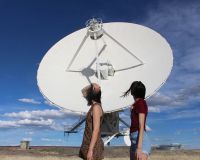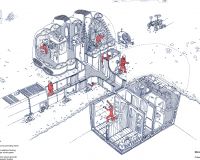Posted on Wed 26 Feb 2020
Maintenance on Mars
Life on Mars might be less Star Trek than you'd imagine. Could it show us a slower paced life with a different focus? What will people on Mars do all day? What do people on Earth do all day?

Posted by

Ella Good
Ella Good works in collaboration with artist Nicki Kent to create socially engaged projects. The duo are currently making a ten year series of works called A Decade With Mars.Project

Building A Martian House
A collaboration with scientists, architects, and the artists' local community to design and plan the build of a functional Martian house.Cal gazed out of the window in front of her over the red, dusty Martian landscape. No matter how long you’d been here the view from the window of the living pods never got old. It held an other worldly, alien quality that was as exciting to look upon as the day they’d first landed. She held the handles of a large crank which was fashioned like a water wheel, and spun it again, around and around. She pretended once more that she was at the helm of an old fashioned ship, turning the steering wheel and propelling herself across an open sea.
Here on Mars, each member of the 100 person community was responsible for a daily hour of power generation activity. After breakfast everyone gathered in the village hall and ran together, walked together, lifted weights or pedalled. This then fed into the grid to meet the basic power needs of the whole community. Beyond that, each person was responsible for their own personal energy consumption in their own house. So if you wanted to have the lights on past nightfall, or have some friends over and play music, you could use some of the many simple human powered machines around your living pod to generate extra power for yourself.
Thanks to her 10 minute stint, Cal calculated she would now be able to turn on the laptop and send some brief emails to her friends back on Earth. She thought back to their lives and marvelled at the difference in how she used to live, driving back and forth to work everyday and stopping off at the gym afterwards.
The sun was starting to go down and the familiar blue tinge was beginning to creep across the sky…
Image: NASA – sunset on Mars

What might a human future on Mars look like?
For several years, we’ve been exploring this question and it’s relevance to our lives on Earth by designing our version of a Martian House, through a process involving many people sharing ideas, having conversations and imagining what the future might look like. The project has really become about what is possible to make when you bring people together in an impossible sounding endeavour and how we can create democratic, collaborative structures to imagine, design and explore visions of the future together.
This year as part of our residency with The Watershed and MAYK we are starting to think about the internal systems and technologies for the house, and what relationship our design ideas and our process might have on the way we think about visions of the future and our daily lives here on Earth, today.
When you imagine a science fiction vision of the future with people living on other planets, your first thoughts might be a world so futuristic where all aspects of daily life are automated; cars drive themselves, food appears at the push of a button, doors are voice activated, furnishings change colour to suit your mood.
It’s easy to imagine a near future that is very similar to today. However Building A Martian House is a place where we hope to explore and imagine new ways of living, not to just re-design a more futuristic version of what we’ve already got. We’re reminding ourselves of this in our process at the moment – for example – thinking about how we would power a house on Mars isn’t just an exercise to create a working solar panel that could cope with dust storms. A better way to look at how you might approach powering a Martian House could be as a prompt to reassess your expectations of what is really necessary in terms of power. Beyond essential life support systems, is 24 hour power a realistic concept on Mars? Is it a realistic concept for Earth? Would we be able to maintain the same lifestyles as we have now if we really were starting all over again? Would we choose to?
An interesting project we’ve come across lately is The Human Power Plant. Artist Melle Smets is investigating the feasibility of human energy production in the 21st century by designing a 750 person student community which would be powered entirely by its inhabitants using a variety of exercise machines, cranks and levers.
It’s a really interesting concept. If you are responsible for your own power generation you are much more likely to think carefully about what you use, and adjust your expectations of what you need. Could we apply this same idea to life on Mars? People on Mars will need to exercise more than on Earth to help their bodies cope with the slightly lower gravity. Combining useful power generating activities with looking after your health and well being through exercise would make a lot of sense. It’s quite a challenging idea to even imagine yourself living somewhere like The Human Power Plant because it requires a complete restructuring of day to day life. Routines would be different. Work and its purpose would be focused differently to how we live now. But if we’re really imagining starting all over again then through Building A Martian House we could test ideas like these which would radically restructure how modern life currently works.
We’re starting to imagine our Martian House being fitted out with appliances like pedal powered washing machines, or running machines that keep the lights on. A place where everything isn’t just done at the flick of a switch, but where we consider everything we use and how we make it work. We’ve just launched a call out for people in Bristol to join our ‘Martian House Makers Group’. We’re forming a group of enthusiasts who are up for re-imagining some of these household appliances with us and re-making them in ways that make us evaluate modern life.
Within the scenario of such an alien place as Mars it becomes more possible to think outside of how we live here and now – to imagine society taking different directions, led by different purposes, different points of convergence; parallel universes.
When we’re doing workshops for Building A Martian House, people often ask what will people be doing on Mars all day? What are their jobs? What is their lifestyle like? Will it be boring? We’ve started to think of people on Mars as being like caretakers. Their roles would be focused around the needs of a small community sustaining themselves. Here on Earth our communities are bigger, less defined. The systems and jobs that sustain our society and how things keep working have become more complex and abstracted. We outsource. Our lives are more abstracted from the task of looking after ourselves, our communities, and where we live. But in essence our needs to live well on Earth are the same as they are on Mars. Beyond caring for yourself and your community, keeping things functioning, what else do you need? Space to think, to dream? Time to talk, reflect, make art? What do people on Earth do all day?
Life on Mars might be less Star Trek than you’d imagine and perhaps shows us more of a slow paced kind of life that places the focus around acts of maintenance, care, repair. If you turn the spotlight back on Earth again it’s funny that the roles that become central in our Martian House scenario are – in the words of artist Mierle Laderman Ukeles ‘the maintenance workers’ of society – the cleaners, the bin men, the care-givers, the mothers. Those who keep the home fires burning.